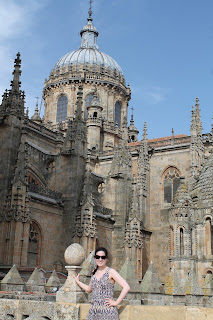We started off at a tapas bar on one of the side streets, and then returned to Plaza Mayor so that we could enjoy another round while we waited for the lights to come on one last time. We sat on one of the many terraces, passing a plate of tortilla and making each other laugh with grammar jokes that only Spanish teachers would appreciate. When the plaza finally lit up, we applauded and oohed just like every one else, partly because that's just the nightly tradition and partly because it never stops being beautiful. Shortly afterwards, we headed back to our residence hall, where I packed and then settled down for one final night in my little oven of a dorm room.
The following morning, we headed over to Patio de Escuelas for our last morning of classes. All three of our teachers talked about how they would miss us, and the feeling was mutual. Carmen shared that there is something special about teaching a group of teachers, and I completely understand what she means. Enrique finished off his art unit by discussing the last half of Goya's career and life, and thanked us for being such a good class. Sonia was the usual hilarious ball of energy, and she very sweetly told us that her home would always be open to us upon our return to Salamanca. One of the directors of the Cursos Internacionales dropped by Sonia's class to present us with our official certificates of completion of the course. She told us that we were now part of the family and history of the nearly 800 year old institution of the Universidad Salamanca, and that we would be welcome back at any time. Afterward, Sonia posed with each of us and our certificates.
In addition, my classmate Miriam surprised each of us with a matching keychain featuring el botón charro. This is a traditional symbol of Salamanca, and most of us purchased a bit of jewelry featuring this design, but the fact that we each have a matching trinket makes me feel like we're all part of the same secret club. I know that every time I look at it, I'm going to think of the friends that I made on this trip. Thanks, Miriam!
Once our classes were over, most of us went back to the residence hall for one final meal. The cafeteria food wasn't necessarily the most perfect example of Spanish cuisine, but the fact that it was always ready and waiting for me - and that I never had to life a finger - made it taste just fine. I think I've hit my french fries quota for a while, though.
After lunch, most of us went back to our dorms to pick up our luggage, and then we walked over to the bus station to catch buses to Madrid. We said our farewells, hugging and giving each other the customary kiss on each cheek. I'm going to miss these ladies!
Irma and I had booked a hotel room for us to share near the Madrid Airport, since we were both flying out around the same time the next day. Once we checked in, we made the very lengthy trek into the heart of downtown via metro. We were pretty tired so we decided to take a few pictures to prove that we had been there before getting a bite to eat.
Puerta del Sol (kind of like the Times Square of Madrid)
On our way back to the hotel, Irma and I decided to walk to the closest line 8 station rather than deal with the hour long commute and two metro transfers that we had our way in to Plaza del Sol. We wound up walking for miles to make this happen, but at least we got some pretty nighttime shots of el Palacio de Comunicaciones. I forgot how beautiful the changing lights on this building are after the sun goes down.
Eventually, we made it back to our hotel (after the requisite ice cream stop, of course), and I proceeded to have the best night's sleep of this entire trip. Thank you, air conditioning and comfortable pillows!
This morning, I woke up refreshed and ready to return to the States, but I was unfortunately greeted with the email that every traveler dreads; my flight was delayed. I headed to the airport at the appointed time anyway, because you never know what could happen. Irma and I were scheduled to depart from different terminals, so we hugged goodbye on the shuttle bus before parting ways. I hope I get to see her again!
I got to the airport and proceeded to wait in line at check-in for an hour and 15 minutes. Apparently, I'm lucky to not have a layover, because most of the people ahead of me spent as much as 20 minutes at the check-in counters, trying to make alternate plans after realizing that they would never make their connecting flights. There are a lot of people who will be spending nights in various airports throughout the US and Europe tonight, so I am grateful that I will get to sleep in my own bed this evening. Plus, my check-in agent was so kind in spite of the fact that I'm sure she had been yelled at all morning by disgruntled travelers. An understanding smile goes a long way.
So that takes me to the present, where I sit here idly in one of the airport cafes. One of the perks of my delay was the free meal voucher that prevented me from having to pay out of pocket for high-priced airport food. I can't wait to get home to hug my sweet little girl and have a belated anniversary celebration with my hard-working husband (eight years of marriage as of yesterday!). Come on plane, hurry up and get here!


















































